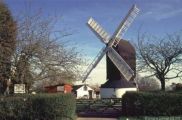
OUTWOOD IN SURREY "The Village with the Mill"
July 2012
Less than a week to go before midsummer's day and at the time of writing the rain is yet again lashing the windows and high winds are doing their best to strip the young leaves off trees and shrubs and both night and daytime temperatures are below normal for the time of year. The old country sayings such as "Oak before ash we're in for a splash. Ash before oak we're in for a soak." seem to be completely at variance with the weather over the last three months. This year ash trees were much later coming into leaf than oaks and we would have expected a great summer to match the water boards expectations and their hose pipe bans. But maybe we will have a pleasant surprise in July, August and September but keep the umbrellas handy.
Plants and flowers generally relish these wet, cool conditions but insects and particularly butterflies have been badly affected and sightings have been limited. Orange tip butterflies (Anthocharis cardamines) that feed on their host plants such as Garlic mustard (Alliaria petiolata) and Lady's smock (Cardamine pratensis) were seen in early April but very few since. The Orange tip to the wings, which make this butterfly so easy to see, is the sign that they are males because the females, which are more difficult to spot, have white wings with black tips. The Garlic Mustard plant which they feed from is a common wild flower to be seen growing alongside hedges leading to their old country name Jack by the Hedge. The plant is a biennial and member of the cabbage and mustard family; when crushed the leaves smell of garlic and have a taste which is a combination of that and mustard and country salad recipes included the chopped leaves and flowers. The small number of other butterfly species seen around the village have been limited to a few cabbage whites, meadow browns and just two red admirals.
Anne Hooper Smith reported an odd sighting whilst in her car near the junction with Chapel Road and Rookery Hill. The subject was described as a large bird with a wide wingspan and the nearest guess is that it might have been a Marsh Harrier or possibly a Hen Harrier. July Biddles reported a similar sighting last year on the fields just south of Burstow Park Farm which she thought was a Marsh Harrier and believed that it tied in with a sighting reported in the Surrey Mirror. Elsewhere in the bird world the Gold Finches that nested in the rose near the kitchen window were successfully hatched, fledged and have now flown the nest. The Blue Tits in one of the boxes have also now flown together with the House Sparrows that were nesting in yet another box. Two pairs of birds built nests in the garden shed. The first was a Blackbird's nest into which two eggs were laid before being deserted and secondly a Robin that laid 5 eggs in a nest behind an old besom. However, I fear the Robin chicks may have met a sticky end.
Whilst clearing dying bluebell leaves I suddenly came across what looked like a greyish brown coloured stone and as I went to absentmindedly pick it up I realised it was a beautiful specimen of a Common Toad or Europaen Toad (Bufo bufo). It had been taking shelter under the moist debris as they do during daytime, before a night time hunting expedition for their favourite meal of invertebrates.
Mike Johnson